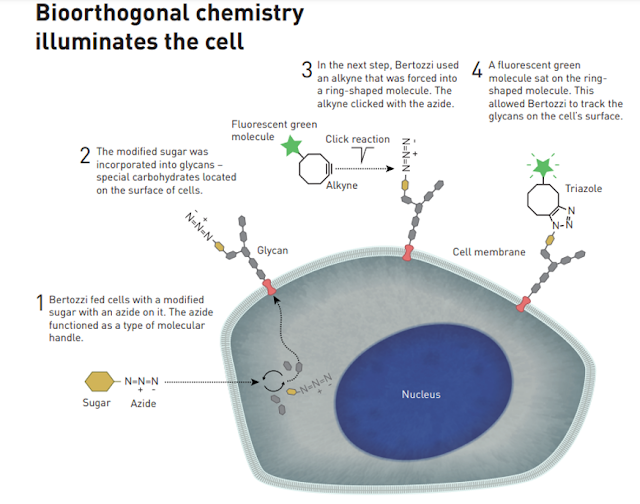Nobel Prize in Chemistry 2022 was awarded to three scientists for for the development of ‘click chemistry’ and bioorthogonal chemistry”
1.
Barry Sharpless of Scripps
Research, USA,
2.
Carolyn R.
Bertozzi of Stanford
University, USA and
3.
Morten Meldal of University of Copenhagen, Denmark.
 |
| Image credit https://www.nobelprize.org/ |
Click Chemistry
a) The term “click
chemistry” was coined by Barry Sharpless
b) Click chemistry
refers to a group of reactions that are fast, simple to use, easy to purify,
versatile, and give high product yields. Combining
molecules together in simple reactions forming a product without any or minimum
by products or intermediate products c) Characteristics of click reaction: include simple reaction conditions
d) Barry Sharpless
and Morten Meldal independently discovered the first click reaction copper
catalysed azide-alkyne cycloaddition. e) Wide
applications in a wide variety of research areas, including materials sciences,
polymer chemistry, and pharmaceutical sciences. |
Bioorthogonal Chemistry
a) The term Bioorthogonal
Chemistry was coined by Carolyn Bertozzi
 |
| Image credit https://www.nobelprize.org/ |
b) Bioorthogonal
chemistry is a set of rapid reactions that can take place in biological
environments without affecting biomolecules or interfering with biochemical
processes.
c) Carolyn Bertozzi developed click reactions that work inside living organisms without any toxic effects.
d) The earliest bioorthogonal reaction developed was a modified Staudinger ligation; strain induced azide-alkyne cycloaddition; a biorthogonal reaction and a click reaction developed by Bertozzi’s team.
d) Wide applications in imaging, identifying, and characterizing biomolecules genetic code expansion and metabolic engineering, drug target identification, antibody–drug conjugation and drug delivery.
*copper catalysed azide-alkyne cycloaddition is not a biorthogonal reaction as copper is toxic to cells.
References
Scinto SL, Bilodeau DA,
Hincapie R, Lee W, Nguyen SS, Xu M, Am Ende CW, Finn MG, Lang K, Lin Q, Pezacki
JP, Prescher JA, Robillard MS, Fox JM. Bioorthogonal chemistry. Nat Rev Methods
Primers. 2021;1:30.
Hein CD, Liu XM, Wang D.
Click chemistry, a powerful tool for pharmaceutical sciences. Pharm Res. 2008
Oct;25(10):2216-30.
Bird, R. E., Lemmel, S. A., Yu, X., & Zhou, Q. A. (2021). Bioorthogonal chemistry and its applications. Bioconjugate Chemistry, 32(12), 2457-2479.
Post a Comment
We Love to hear from U :) Leave us a Comment to improve this site
Thanks for Visiting.....